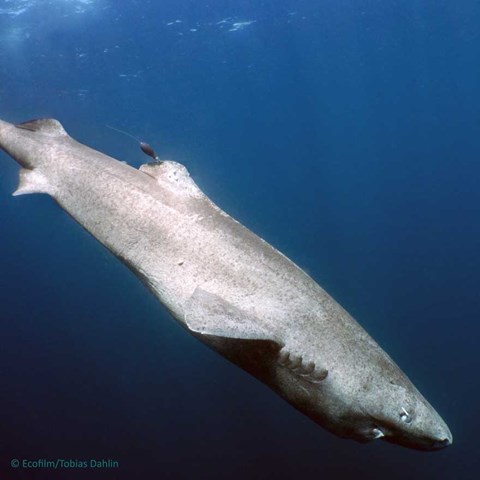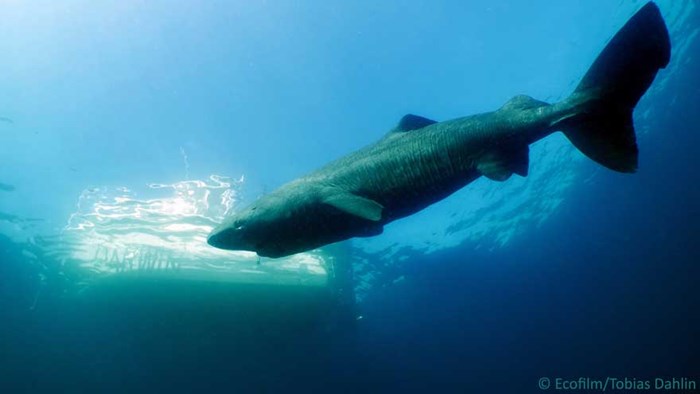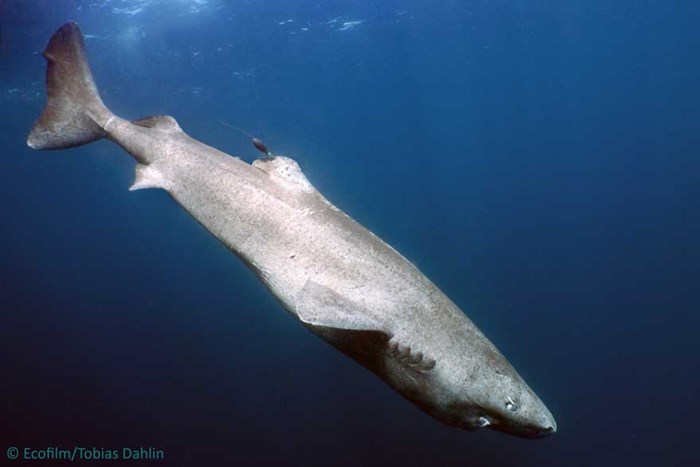For the first time, researchers track the threatened deep-sea shark, the Greenland shark, in Swedish waters. These sharks can live for hundreds of years and they are threatened by both fishing and climate change. The researchers are studying their behaviour, movement patterns, population structure, and potential impact from chemical pollution – all of which are important knowledge for species conservation.
As interest in exploitation of the deep sea increases, the threat to its inhabitants grows. Species with slow growth and reproductive rates are particularly vulnerable. To understand how to best protect these fascinating animals, researchers at the Swedish University of Agricultural Sciences (SLU) have started tracking Greenland sharks living at depths of over 600 meters in the Skagerrak Sea. The largest individual tagged so far was over 4.5 meters long and weighed over 600 kg.
“It is one of the largest carnivorous shark species," says Gustav Hellström, researcher at the Department of Wildlife, Fish, and Environmental Studies at SLU in Umeå, Sweden.
Greenland sharks are mainly found in the North Atlantic and Arctic Ocean, where they can live at depths of up to two thousand meters. Very little is still known about their biology, behaviour and migration patterns.
“The environment down there in the deep is extremely different from our world up here. Cold, dark and desolate," says Gustav Hellström. In that environment, these giant animals slowly cruise around, and the fact that we have them in Swedish waters is fascinating, but it also gives us a responsibility for their conservation.
The great depths make it difficult to study these animals. Researchers at SLU therefore rely on experienced fishing teams to catch the fish. During the tagging procedure, the sharks are handled as gently as possible. The shark is kept underwater at all times and soft ropes are used to handle the shark in the water next to the boat for a few minutes. The same method is used by other shark researchers around the world.
A pioneering project
The project, which is the first of its kind in Sweden, aims to track around 30 individuals. So far, 20 sharks have been fitted with transmitters on their dorsal fins.
A Greenland shark can live to be very old, hundreds of years, and is likely to be sensitive to chemical pollution, fishing and climate change. Based on existing information, the shark does not become sexually mature until it is about 100 years old, which puts special demands on the conservation and management of the species. To protect these sharks, researchers at SLU want to better understand their migration patterns, behaviour, and survival. They do this by tagging the shark with sensors that collect high-resolution data on activity and behaviour. It is only in recent years that technological developments have enabled behavioural research on these deep-sea sharks.
“We attach a small satellite transmitter to the shark that we program to detach from the shark after a predetermined time. The time depends on what we want to answer with that particular transmitter. The transmitter then floats up to the surface and sends archived information about the depths at which the shark lives, its activity and surrounding temperature, to us via satellite," says Petter Lundberg, postdoctoral researcher at SLU. In addition, we also tag them with acoustic transmitters, to be able to track the sharks over a longer period.
In addition to tagging the sharks, the researchers also take many other samples.
“Among other things, we plan to measure levels of various chemical pollutants. This is particularly interesting as these sharks are so long-lived," says Tomas Brodin, professor at SLU.


